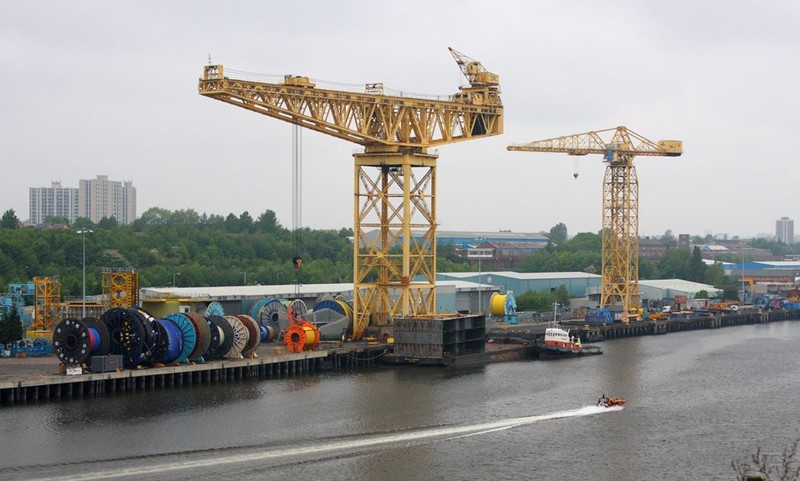

|
Edward Lowton
Editor |


|
| Home> | Handling and Storing | >Cranes and hoists | >Modernisation programme for historic crane |
Modernisation programme for historic crane
07 August 2015
Exemplifying the results that can be achieved through a crane modernisation programme is Konecranes’ extensive refurbishment of the river Tyne's most historic Hammerhead heavy lifting crane, which worked on such vessels as Ark Royal and HMS Illustrious.

Operated by Shepherd Offshore and located within its Walker Quays Offshore Technology Park, the modernisation work undertaken by Konecranes increased the crane’s lifting capacity from 250 to 325t.
In undertaking the overhaul work on the 1930s Walker Quays located crane – initiated by Shepherd Offshore and undertaken on behalf of Newcastle City Council at a cost of £750K – both parties were confident that the refurbishment project would help local engineering firms benefit from millions of pounds of additional orders, whilst also boosting the region’s competitive advantage.
Indeed since increasing its lifting capacity, the crane, which forms part of a Shepherd Offshore facility that stands as a unique and world leading offshore and marine cargo handling terminal, has opened up interest from a wider range of offshore energy customers keen to drive inward investment, whilst substantially reducing logistical costs to local and international manufacturers.
Involving a complex restoration programme, it was Konecranes’ crane modernisation team who supported local Newcastle-based crane service engineers in undertaking the work. As Tom Dunleavy, product support manager at Konecranes who worked on the refurbishment and who was responsible for crane maintenance in his shipyard days with Swan Hunter, said: "It was fascinating to be involved in a project that ensured one of the oldest cranes in recent history was rejuvenated and is today still going strong.
"The complex restoration of a remarkable piece of heritage infrastructure has already secured employment opportunities, generated additional work and introduced new businesses to the area. As a major player in the field of crane modernisation programmes, we are continuing to see an increase in their popularity across many industry sectors. Customers are realising the benefits of tapping into a cost-effective process that is efficient in providing the latest productivity, technology and safety standard advances,” he added.
At the time, Cllr Nick Forbes, Leader of Newcastle City Council, said: "The creation of jobs and attracting investment are vital to the region’s economy, which is why the council was prepared to loan the money for the crane to be refurbished.
"It’s a great example of a public private partnership as an effective way of boosting economic growth, and a commitment by the council to invest during the recession, so we were well placed to compete when the economy picked up.”
The programme of modernisation was implemented following a 12 month design and feasibility study undertaken by Konecranes and specialist design company, Carlisle-based Des-Cad Ltd, which centred on increasing the crane’s capacity to 320 tonnes. The main items brought out by the design study for upgrade covered the bottom block sheaves and block hook. The former were identified as needing roller bearings that were introduced to replace the existing plain bush bearings, whilst the latter was unsuitable for 320 tonne loads. The plain bush bearings of the top sheaves, of which there were eight, were also changed to roller bearings. Additionally, the jib end sheave and surrounding assembly steelwork were replaced, as were the load rope and load rope guide rollers.
In terms of additional technologies deployed as part of the crane modernisation programme, a PAT Kruger load monitoring and overload protection system was installed, as was Konecranes' ControlPro & TRUCONNECT remote monitoring system that was introduced as a secondary interfaced device. Finally, specialist structural health monitoring company, McFarland Associates Ltd, installed state-of-the-art fibre optic strain gauge sensors onto the key structural support members. The sensors dynamically measure the tension/compression stress of the members under various loads, at various radii and in various wind/temperature conditions. The sensors are fed into an interrogator unit (located on the crane) where information is processed and via GPRS signal and fed to a server for 24/7 remote monitoring.
Konecranes’ crane modernisation schemes broadly fall into one of two categories: pre-engineered upgrades and engineered crane modernisations. Within the former process, Konecranes offers upgrades and smaller improvements that can be applied to equipment conveniently at a customer’s site or sites. These upgrade services improve the functionality of the cranes, therefore cutting down on the incidence of repeated failures that often result in inconvenient downtime and associated increase in cost.
Before recommending any form of crane modernisation, Konecranes will take an inventory of performance needs and examine the reliability of existing structures to prevent potential safety issues. Konecranes will also examine the condition of parts and recommend replacing those with the greatest wear and tear. Armed with this information, Konecranes will then recommend the most cost-efficient upgrades that are required, but always keeping in mind the existing materials and structure.

















